Co-Teaching: Difference between revisions
| Line 104: | Line 104: | ||
=Conclusions= | =Conclusions= | ||
The main goal of the paper is to introduce “Co-teaching” learning paradigm that uses two deep neural networks learning | The main goal of the paper is to introduce the “Co-teaching” learning paradigm that uses two deep neural networks learning simultaneously to avoid noisy labels. Experiments are performed on several datasets such as MNIST, CIFAR-10, and CIFAR-100. The performance varied depending on the noise level in different scenarios. In the simulated ‘extreme noise’ scenarios, (pair-45% and symmetry-50%), the co-teaching methods outperforms baseline methods in terms of accuracy. This suggests that the co-teaching method is superior to the baseline methods in scenarios of extreme noise. The co-teaching method also performs competitively in the low-noise scenario (symmetry-20%). | ||
=Critique= | =Critique= | ||
Revision as of 13:35, 6 November 2018
Introduction
Title of Paper
Co-teaching: Robust Training Deep Neural Networks with Extremely Noisy Labels
Contributions
The paper proposes a novel approach to training deep neural networks on data with noisy labels. The proposed architecture, named ‘co-teaching’, maintains two networks simultaneously. The experiments are conducted on noisy versions of MNIST, CIFAR-10 and CIFAR-100 datasets. Empirical results demonstrate that, under extremely noisy circumstances (i.e., 45% of noisy labels), the robustness of deep learning models trained by the Co-teaching approach is much superior to state-of-the-art baselines.
Terminology
Ground-Truth Labels: The proper objective labels (i.e. the real, or ‘true’, labels) of the data.
Noisy Labels: Labels that are corrupted (either manually or through the data collection process) from ground-truth labels.
Intuition
The Co-teaching architecture maintains two networks with different learning abilities simultaneously. The reason why Co-teaching is more robust can be explained as follows. Usually while learning on a batch of noisy data only the error from the network itself is transferred back to facilitate learning. But in the case of Co-Teaching the two networks that are used are able to filter the different type of errors which flows back to themselves as well as the other network. Therefore the models learn mutually, i.e., from themselves as well as from the partner network.
Motivation
The paper draws motivation from two key facts:
• That many data collection processes yield noisy labels.
• That deep neural networks have a high capacity to overfit to noisy labels.
Because of these facts, it is challenging to train deep networks to be robust with noisy labels.
Related Works
Some approaches use statistical learning methods for the problem of learning from extremely noisy labels. These approaches can be divided into 3 strands: surrogate loss, noise estimation, and probabilistic modeling.
In the surrogate loss category, one work proposes an unbiased estimator to provide the noise corrected loss approach. Another work presented a robust non-convex loss, which is the special case in a family of robust losses. In the noise rate estimation category, some authors propose a class-probability estimator using order statistics on the range of scores. Another work presented the same estimator using the slope of ROC curve. In the probabilistic modeling category, there is a two coin model proposed to handle noise labels from multiple annotators.
There are also deep learning approaches that can be used to approach data with noisy labels. One work proposed a unified framework to distill knowledge from clean labels and knowledge graphs. Another work trained a label cleaning network by a small set of clean labels and used it to reduce the noise in large-scale noisy labels. There is also a proposed joint optimization framework to learn parameters and estimate true labels simultaneously. Another work leverages an additional validation set to adaptively assign weights to training examples in every iteration. One particular paper ads a crowd layer after the output layer for noisy labels from multiple annotators.
Learning to teach methods is another approach to this problem. The methods are made up by the teacher and student networks. The teacher network selects more informative instances for better training of student networks.
Co-Teaching Algorithm
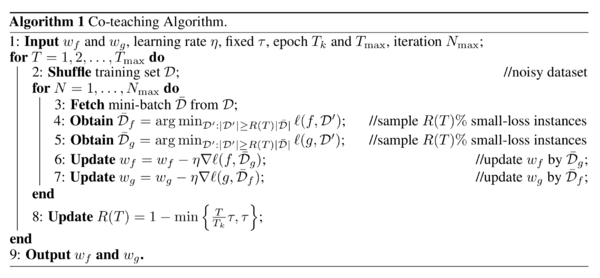
The idea as shown in the algorithm above is to train two deep networks simultaneously. In each mini-batch, each network selects its small-loss instances as useful knowledge and then teaches these useful instances to the peer network.
Summary of Experiment
Proposed Method
The proposed co-teaching method maintains two networks simultaneously, and samples instances with small loss at each mini batch. The sample of small-loss instances is then taught to the peer network.
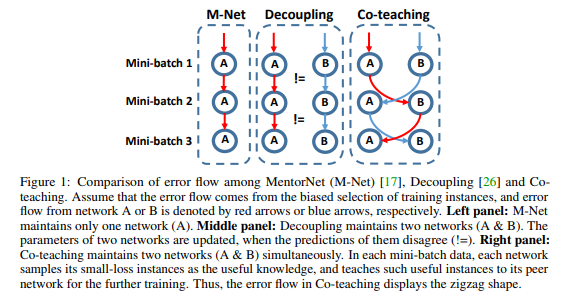
The co-teaching method relies on research that suggests deep networks learn clean and easy patterns in initial epochs, but are susceptible to overfitting noisy labels as the number of epochs grows. To counteract this, the co-teaching method reduces the mini-batch size by gradually increasing a drop rate (i.e., noisy instances with higher loss will be dropped at an increasing rate). The mini-batches are swapped between peer networks due to the underlying intuition that different classifiers will generate different decision boundaries. Swapping the mini-batches constitutes a sort of ‘peer-reviewing’ that promotes noise reduction since the error from a network is not directly transferred back to itself.
Dataset Corruption
To simulate learning with noisy labels, the datasets (which are clean by default) are manually corrupted by applying a noise transformation matrix. Two methods are used for generating such noise transformation matrices: pair flipping and symmetry.

Three noise conditions are simulated for comparing co-teaching with baseline methods.
| Method | Noise Rate | Rationale |
| Pair Flipping | 45% | Almost half of the instances have noisy labels. Simulates erroneous labels which are similar to true labels. |
| Symmetry | 50% | Half of the instances have noisy labels. Further rationale can be found at [1]. |
| Symmetry | 20% | Verify the robustness of co-teaching in a low-level noise scenario. |
Baseline Comparisons
The co-teaching method is compared with several baseline approaches, which have varying:
• proficiency in dealing with a large number of classes,
• ability to resist heavy noise,
• need to combine with specific network architectures, and
• need to be pretrained.

Bootstrap
A method that deems a weighted combination of predicted and original labels as correct, and then solves kernels by backpropagation [2].
S-Model
Using an additional softmax layer to model the noise transition matrix [3].
F-Correction
Correcting the prediction by using a noise transition matrix which is estimated by a standard network [4].
Decoupling
Two separate classifiers are used in this technique. Parameters are updated using only the samples that are classified differently between the two models [5].
MentorNet
A teacher network is trained to identify and discard noisy instances in order to train the student network on cleaner instances [6].
Implementation Details
Two CNN models using the same architecture (shown below) are used as the peer networks for the co-teaching method. They are initialized with different parameters in order to be significantly different from one another (different initial parameters can lead to different local minima). An Adam optimizer (momentum=0.9), a learning rate of 0.001, a batch size of 128, and 200 epochs are used for each dataset. The networks also utilize dropout and batch normalization.
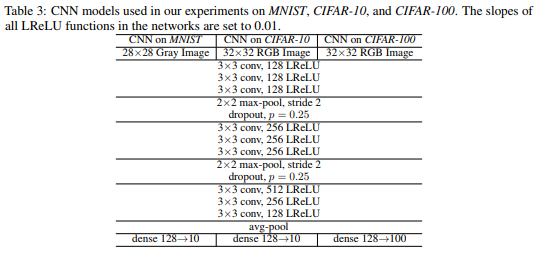
Results and Discussion
The co-teaching algorithm is compared to the baseline approaches under the noise conditions previously described. The results are as follows.
MNIST
The results of testing on the MNIST dataset are shown below. The Symmetry-20% case can be taken as a near-baseline; all methods perform well. However, under the Symmetry-50% case, all methods except MentorNet and Co-Teaching drop below 90% accuracy. Under the Pair-45% case, all methods except MentorNet and Co-Teaching drop below 60%. Under both high-noise conditions, the Co-Teaching method produces the highest accuracy. Similar patterns can be seen in the two additional sets of test results, though the specific accuracy values are different. Co-Teaching performs best under the high-noise situations
The images labelled 'Figure 3' show test accuracy with respect to epoch of the various algorithms. Many algorithms show evidence of over-fitting or being influenced by noisy data, after reaching initial high accuracy. MentorNet and Co-Teaching experience this less than other methods, and Co-Teaching generally achieves higher accuracy than MentorNet.

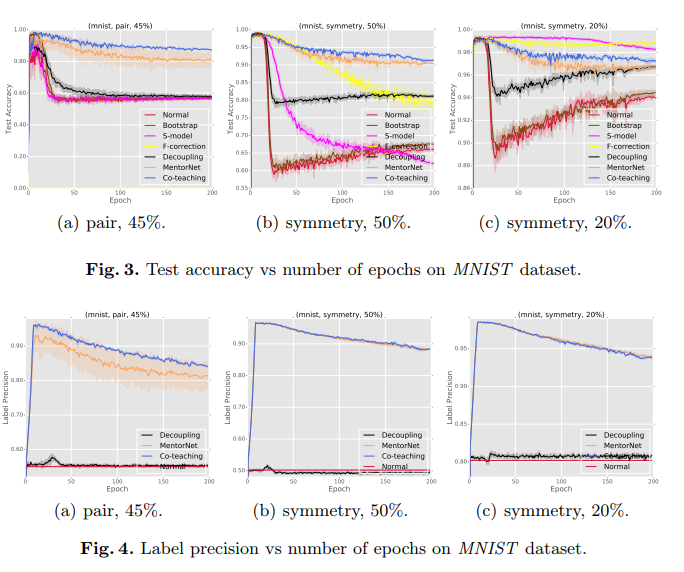
CIFAR10

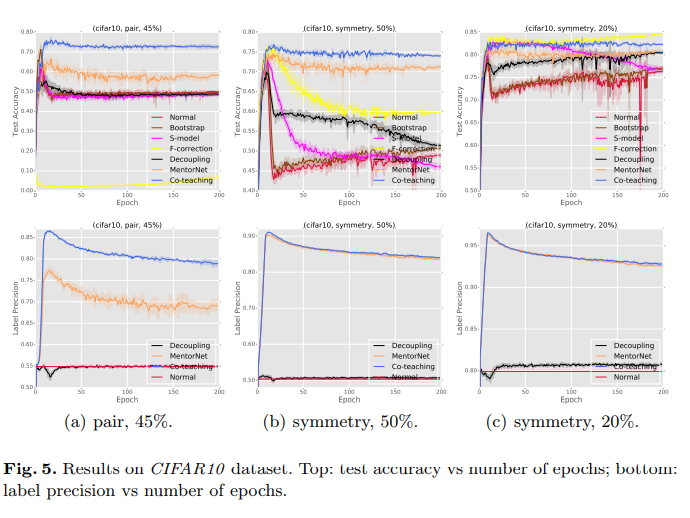
CIFAR100

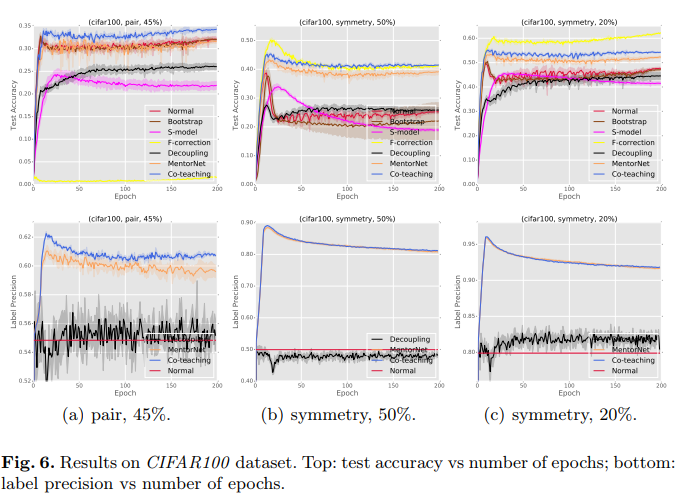
Conclusions
The main goal of the paper is to introduce the “Co-teaching” learning paradigm that uses two deep neural networks learning simultaneously to avoid noisy labels. Experiments are performed on several datasets such as MNIST, CIFAR-10, and CIFAR-100. The performance varied depending on the noise level in different scenarios. In the simulated ‘extreme noise’ scenarios, (pair-45% and symmetry-50%), the co-teaching methods outperforms baseline methods in terms of accuracy. This suggests that the co-teaching method is superior to the baseline methods in scenarios of extreme noise. The co-teaching method also performs competitively in the low-noise scenario (symmetry-20%).
Critique
Lack of Task Diversity
The datasets used in this experiment are all image classification tasks – these results may not generalize to other deep learning applications, such as classifications from data with lower or higher dimensionality.
Needs to be expanded to other weak supervisions (Mentioned in conclusion)
Adaptation of the co-teaching method to train under other weak supervision (e.g. positive and unlabeled data) could expand the applicability of the paradigm.
Lack of Theoretical Development (Mentioned in conclusion)
This paper lacks any theoretical guarantees for co-teaching. Proving that the results shown in this study are generalizable would bolster the findings significantly.
References
[1] A. Gramfort, M. Luessi, E. Larson, D. A. Engemann, D. Strohmeier, C. Brodbeck, L. Parkkonen, and M. S. Hämäläinen. MNE software for processing MEG and EEG data. Neuroimage, 86:446–460, 2014.
[2] P. Richtárik and M. Takáč. Iteration complexity of randomized block-coordinate descent methods for minimizing a composite function. Mathematical Programming, 144(1-2):1–38, 2014.
[3] M. Jas, T. Dupré La Tour, U. Şimşekli, and A. Gramfort. Learning the morphology of brain signals using alpha-stable convolutional sparse coding. In Advances in Neural Information Processing Systems (NIPS), pages 1–15, 2017.
[4] J. Friedman, T. Hastie, H. Höfling, and R. Tibshirani. Pathwise coordinate optimization. The Annals of Applied Statistics, 1(2):302–332, 2007.
[5] R. Chalasani, J. C. Principe, and N. Ramakrishnan. A fast proximal method for convolutional sparse coding. In International Joint Conference on Neural Networks (IJCNN), pages 1–5, 2013. ISBN 9781467361293.
[6] F. Heide, W. Heidrich, and G. Wetzstein. Fast and flexible convolutional sparse coding. In Computer Vision and Pattern Recognition (CVPR), pages 5135–5143. IEEE, 2015.